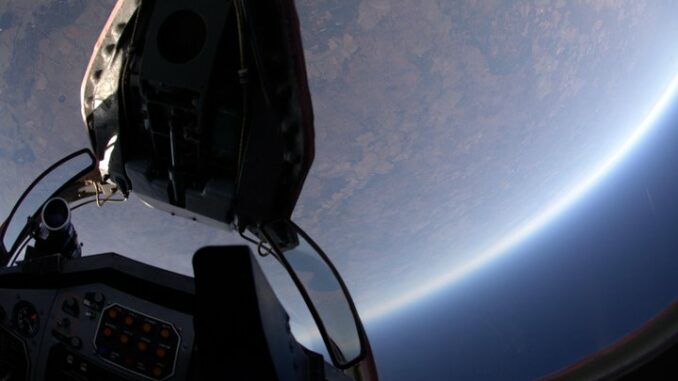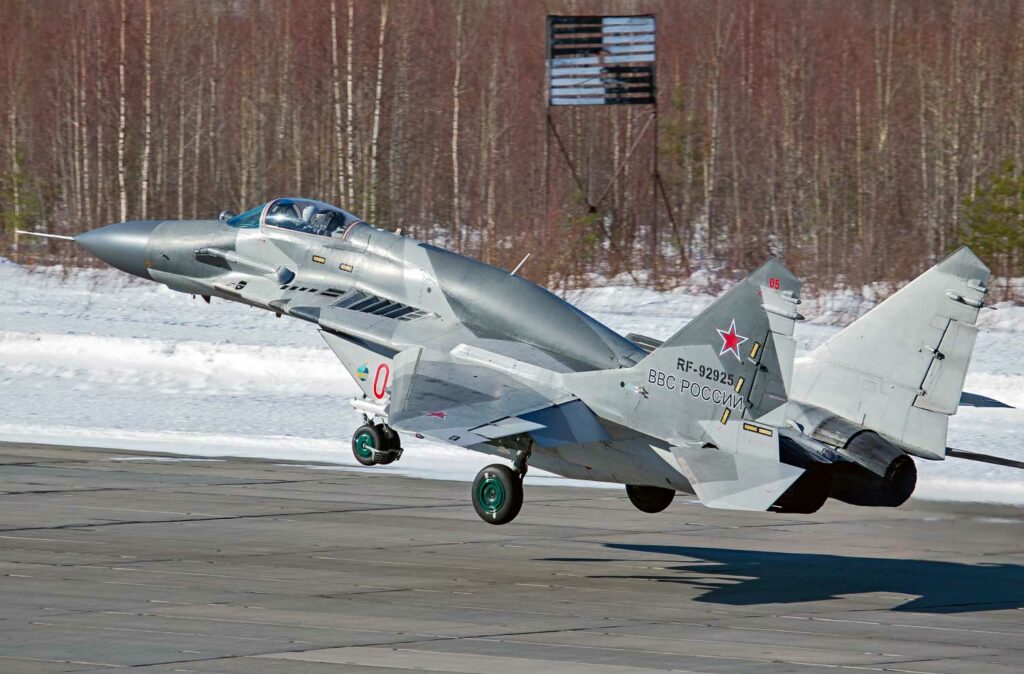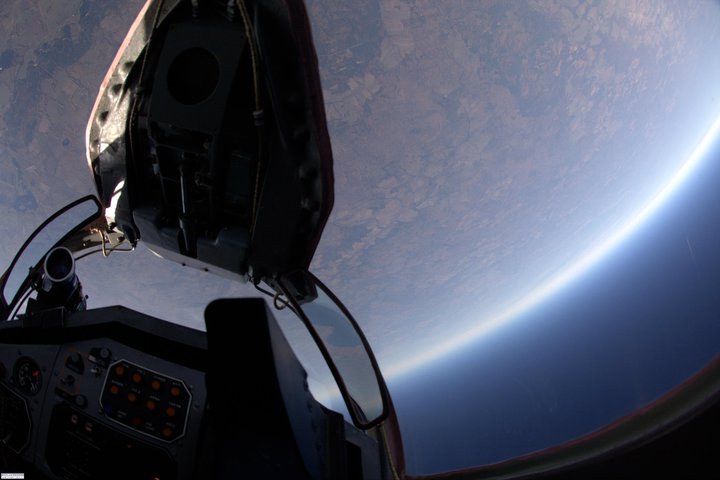
Analysis of fighter jets that have reached the stratosphere, their performance, records, and strategic implications.
The edge of space, defined by the Kármán line at an altitude of 100 km, represents a limit that only a few fighter jets have approached. These aircraft, designed for specific missions, have pushed the boundaries of aeronautics. This article takes a detailed look at fighter jets that have reached stratospheric altitudes, their performance, and the strategic implications of such flights.
The MiG-25 Foxbat: the historic record for stratospheric flight
The Mikoyan-Gurevich MiG-25, designated “Foxbat” in NATO nomenclature, remains one of the few fighter aircraft to have approached the boundary of space. Designed by the USSR in the 1960s, its strategic objective was to intercept American bombers such as the B-70 Valkyrie and U-2 reconnaissance aircraft at very high altitudes.
On August 31, 1977, Soviet test pilot Alexander Fedotov reached an altitude of 37,650 meters, or 123,523 feet, during a special flight as part of a series of record attempts. This flight remains, to this day, the highest ever achieved by a piloted jet aircraft without rocket propulsion. This feat was part of intense technological competition between blocs, where the ability to operate in the stratosphere was of tactical and political importance.
The MiG-25 is equipped with two Tumansky R-15B-300 turbojet engines, capable of propelling the aircraft to Mach 3.2 (approximately 3,400 km/h). However, although this speed threshold was theoretically achievable, it carried the risk of structural deformation due to the high temperatures generated by friction at such speeds. To withstand this, its structure is largely made of stainless steel rather than aluminum, as is the case with most contemporary fighters, as steel is more resistant to high temperatures, although it is heavier.
These exceptional performance characteristics are accompanied by operational limitations: high fuel consumption, poor agility at low altitudes, and heavy radar load. The MiG-25 could not sustain these extreme speeds for long periods without damaging its engines. Its main mission remained rapid interception, on a straight course, in high-altitude flight environments.
Beyond its tactical role, the MiG-25 embodies a Soviet approach focused on brute power rather than technological sophistication. It marked a turning point in the Western perception of Soviet aviation, particularly after Viktor Belenko’s defection in 1976, revealing the reality of its capabilities and limitations.

The SR-71 Blackbird: the operational benchmark for high-altitude flight
The Lockheed SR-71 Blackbird, developed in the utmost secrecy by the Skunk Works division in the early 1960s, represents one of the most advanced achievements in American military aviation. Designed in the context of the Cold War, this strategic reconnaissance fighter jet had to be capable of flying over hostile territory without being intercepted.
On July 28, 1976, an SR-71 set a world record for sustained flight at an altitude of 25,929 meters, or 85,069 feet, while reaching Mach 3.3, the equivalent of 3,540 km/h. This record, still standing for an operational aircraft, has never been broken by another piloted aircraft powered solely by turbojet engines.
The SR-71 is powered by two Pratt & Whitney J58 engines, capable of operating in high-speed ramjet mode. These unique engines enabled the Blackbird to travel more than 4,800 km at Mach 3 without refueling. At this speed, air friction raises the temperature of the airframe to over 300°C. This is why the aircraft is made of over 90% titanium, a metal that is resistant to heat but difficult to machine at the time.
The black coating, often associated with stealth, was actually used to dissipate heat more efficiently. Thanks to its streamlined shape and hybrid propulsion, the SR-71 combined stratospheric flight and extreme speed to avoid interception. Soviet surface-to-air missiles could not catch up with it before the aircraft was out of range.
Retired from service in 1998, the Blackbird remains unique in military history as an aircraft capable of combining high altitude, supersonic speed, and operational autonomy. It also remains a benchmark for technical performance, unmatched in its class. No replacement has yet surpassed it on all three criteria.
The X-15: the only manned aircraft to break the sound barrier
The North American X-15 is a unique American experimental program. Developed in the late 1950s by NASA and the US Air Force, this aircraft was not a fighter jet in the operational sense, but a flying laboratory designed to push the limits of stratospheric and hypersonic flight. It broke through the Kármán line, set at an altitude of 100 km, considered the official boundary of space.
On August 22, 1963, pilot Joseph A. Walker reached 107.8 km, or 354,200 feet, during a mission aboard the X-15 number 3. On this occasion, he became the first man to fly twice beyond the Kármán line without an orbital spacecraft. In total, 13 X-15 flights exceeded an altitude of 80 km, the threshold recognized by the US Air Force for awarding astronaut status.
The X-15 was launched from a Boeing B-52 Stratofortress at an altitude of 13,700 meters to save fuel. Once released, its liquid-fueled XLR99 rocket engine provided up to 250 kN of thrust, propelling the aircraft to Mach 6.7, or approximately 7,274 km/h. To withstand the extreme temperatures generated by air compression at these speeds, the aircraft was constructed from Inconel X alloy, a material resistant to temperatures of over 650°C.
The X-15 had no radar or weapons: it was not designed for combat, but to collect scientific data on high-altitude flight, atmospheric re-entry, and the effects of hypersonic flight on structures and pilots. This research contributed directly to the Mercury, Gemini, and Apollo programs, and later to the design of future high-performance aircraft.
By crossing the stratosphere to reach the exosphere, the X-15 remains the only manned aircraft to have flown beyond the atmosphere under its own power. No other atmospheric aircraft has since matched this performance in a manned context.
The MiG-29 Fulcrum: a fighter jet for civil stratospheric flight
The Mikoyan-Gurevich MiG-29, known as the “Fulcrum” in NATO classification, is primarily a multi-role fighter aircraft designed for short- and medium-range air combat. Entered service in 1983, it was developed to counter the American F-15 and F-16, with an architecture focused on maneuverability and thrust.
The MiG-29 can reach a maximum operational altitude of approximately 18,000 meters (59,000 feet), a remarkable performance, although inferior to that of the MiG-25 or SR-71. However, this capability allows it to operate in the upper atmosphere, at the lower limit of the stratosphere, where the sky turns black and the curvature of the Earth is visible.
This feature has been exploited by some Russian and foreign companies in a non-military context. Companies such as Tematis offer high-altitude commercial flights aboard the MiG-29, departing from the Nizhny Novgorod base in Russia. For prices exceeding $15,000, passengers can experience supersonic flight and climb to the aircraft’s maximum altitude, accompanied by a test pilot.
These flights not only allow passengers to feel the power of a modern military aircraft, but also to observe the stratosphere: an inky sky, low-angled light, and the curvature of the Earth’s horizon. This is not space tourism, but an extreme physical and visual experience, far removed from traditional commercial flights.
Technically, the MiG-29 is equipped with two RD-33 engines, each developing 81 kN of thrust with afterburner, giving it a maximum speed of close to Mach 2.25 (approximately 2,400 km/h). Although its airframe is not designed for prolonged flight at very high altitudes, its robustness and thrust make it a suitable candidate for this type of short climb.
So, while it’s not a record-breaker in terms of altitude, the MiG-29 occupies a special place: it democratizes, to a certain extent, access to high-altitude flight in a fighter jet, with scientific, sensory, and symbolic implications.

The strategic implications of high-altitude flight for fighter jets
The ability to fly at high altitudes, even stratospheric altitudes, gives fighter jets undeniable tactical and strategic advantages. At these altitudes, often above 20,000 meters, aircraft fly above most conventional ground-to-air defense systems, greatly reducing the risk of interception. Anti-aircraft missiles, tracking radars, and enemy aircraft struggle to track or reach targets at such altitudes and speeds, especially at speeds close to Mach 3.
Reconnaissance missions conducted from the stratosphere provide extended visual and electronic coverage. An aircraft such as the SR-71, for example, could scan thousands of square kilometers in a matter of hours, recording images or picking up radar emissions without penetrating deep into enemy airspace. This type of flight ensures low-risk strategic intelligence gathering without the use of satellites, whose orbits are fixed and sometimes predictable.
However, operating at these altitudes poses significant constraints. Aircraft capable of such performance require specific design features: heat-resistant structures, rare materials such as titanium or Inconel, and complex and expensive engines. The initial development cost can reach several hundred million euros, not including regular maintenance, which is made difficult by extreme thermal and mechanical constraints.
Added to this is the evolution of threats. Modern technologies such as metric wave radars, passive infrared tracking systems and hypersonic missiles are challenging the supposed impunity of stratospheric flights. In this context, these aircraft become vulnerable if they are not integrated into a comprehensive system of electronic warfare, air defense suppression and interoperability with other platforms.
Finally, on the political front, the use of aircraft operating at the edge of space generates tensions: their passage can be perceived as a provocation or even a violation of air sovereignty, due to the ambiguity between the atmosphere and outer space.
While stratospheric flight offers tactical superiority in certain situations, its operational effectiveness depends on a detailed analysis of the strategic context, enemy capabilities, and overall operating costs.
Fighter jets capable of flying at the edge of space represent major technological achievements. From the MiG-25 to the SR-71 and the X-15, these aircraft have pushed the boundaries of aeronautics. Their exceptional performance has offered strategic advantages, while posing operational challenges. In the future, technological developments and threats will determine the place of these aircraft in the world’s air forces.
War Wings Daily is an independant magazine.